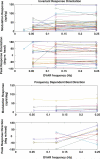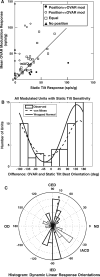Parabrachial nucleus neuronal responses to off-vertical axis rotation in macaques
- PMID: 20039027
- PMCID: PMC2848713
- DOI: 10.1007/s00221-009-2130-9
Parabrachial nucleus neuronal responses to off-vertical axis rotation in macaques
Abstract
The caudal aspect of the parabrachial nucleus (PBN) contains neurons responsive to whole body, periodic rotational stimulation in alert monkeys (Balaban et al. in J Neurophysiol 88:3175-3193, 2002). This study characterizes the angular and linear motion-sensitive response properties of PBN unit responses during off-vertical axis rotation (OVAR) and position trapezoid stimulation. The OVAR responses displayed a constant firing component which varied from the firing rate at rest. Nearly two-thirds of the units also modulated their discharges with respect to head orientation (re: gravity) during constant velocity OVAR stimulation. The modulated response magnitudes were equal during ipsilateral and contralateral OVARs, indicative of a one-dimensional accelerometer. These response orientations during OVAR divided the units into three spatially tuned populations, with peak modulation responses centered in the ipsilateral ear down, contralateral anterior semicircular canal down, and occiput down orientations. Because the orientation of the OVAR modulation response was opposite in polarity to the orientation of the static tilt component of responses to position trapezoids for the majority of units, the linear acceleration responses were divided into colinear dynamic linear and static tilt components. The orientations of these unit responses formed two distinct population response axes: (1) units with an interaural linear response axis and (2) units with an ipsilateral anterior semicircular canal-contralateral posterior semicircular canal plane linear response axis. The angular rotation sensitivity of these units is in a head-vertical plane that either contains the linear acceleration response axis or is perpendicular to the linear acceleration axis. Hence, these units behave like head-based ('strapdown') inertial guidance sensors. Because the PBN contributes to sensory and interoceptive processing, it is suggested that vestibulo-recipient caudal PBN units may detect potentially dangerous anomalies in control of postural stability during locomotion. In particular, these signals may contribute to the range of affective and emotional responses that include panic associated with falling, malaise associated with motion sickness and mal-de-debarquement, and comorbid balance and anxiety disorders.
Keywords: Alert non-human primate; Electrophysiology; Linear acceleration sensitivity; Vestibular.
Figures










Similar articles
-
Neural basis for eye velocity generation in the vestibular nuclei of alert monkeys during off-vertical axis rotation.Exp Brain Res. 1992;92(2):209-26. doi: 10.1007/BF00227966. Exp Brain Res. 1992. PMID: 1493862
-
Responses of primate caudal parabrachial nucleus and Kölliker-fuse nucleus neurons to whole body rotation.J Neurophysiol. 2002 Dec;88(6):3175-93. doi: 10.1152/jn.00499.2002. J Neurophysiol. 2002. PMID: 12466439
-
Rostral fastigial nucleus activity in the alert monkey during three-dimensional passive head movements.J Neurophysiol. 1997 Mar;77(3):1432-46. doi: 10.1152/jn.1997.77.3.1432. J Neurophysiol. 1997. PMID: 9084609
-
Three-dimensional organization of otolith-ocular reflexes in rhesus monkeys. II. Inertial detection of angular velocity.J Neurophysiol. 1996 Jun;75(6):2425-40. doi: 10.1152/jn.1996.75.6.2425. J Neurophysiol. 1996. PMID: 8793754
-
Gravity or translation: central processing of vestibular signals to detect motion or tilt.J Vestib Res. 2003;13(4-6):245-53. J Vestib Res. 2003. PMID: 15096668 Review.
Cited by
-
Distribution of 5-HT1B and 5-HT1D receptors in the inner ear.Brain Res. 2010 Jul 30;1346:92-101. doi: 10.1016/j.brainres.2010.05.057. Epub 2010 May 26. Brain Res. 2010. PMID: 20510890 Free PMC article.
-
Integrative responses of neurons in parabrachial nuclei to a nauseogenic gastrointestinal stimulus and vestibular stimulation in vertical planes.Am J Physiol Regul Integr Comp Physiol. 2012 Apr 15;302(8):R965-75. doi: 10.1152/ajpregu.00680.2011. Epub 2012 Jan 25. Am J Physiol Regul Integr Comp Physiol. 2012. PMID: 22277934 Free PMC article.
-
Distribution of 5-HT1F Receptors in Monkey Vestibular and Trigeminal Ganglion Cells.Front Neurol. 2016 Oct 10;7:173. doi: 10.3389/fneur.2016.00173. eCollection 2016. Front Neurol. 2016. PMID: 27777567 Free PMC article.
-
Visual-vestibular stimulation influences spatial and non-spatial cognitive processing.J Vestib Res. 2012;22(5-6):253-9. doi: 10.3233/VES-2012-00460. J Vestib Res. 2012. PMID: 23302706 Free PMC article.
-
Implementation of linear sensory signaling via multiple coordinated mechanisms at central vestibular nerve synapses.Neuron. 2015 Mar 4;85(5):1132-44. doi: 10.1016/j.neuron.2015.01.017. Epub 2015 Feb 19. Neuron. 2015. PMID: 25704949 Free PMC article.
References
-
- Angelaki DE, Dickman JD. Spatiotemporal processing of linear acceleration: primary afferent and central vestibular neuron responses. J Neurophysiol. 2000;84:2113–2132. - PubMed
-
- Balaban CD. Vestibular nucleus projections to the parabrachial nucleus in rabbits: implications for vestibular influences on autonomic function. Exp Brain Res. 1996;108:367–381. - PubMed
-
- Balaban CD. Vestibular autonomic regulation. Curr Opin Neurol. 1999;12:29–33. - PubMed
-
- Balaban CD. Projections from the parabrachial nucleus to the vestibular nuclei: potential substrates for autonomic and limbic influences on vestibular responses. Brain Res. 2004;996:126–137. - PubMed
-
- Balaban CD, Thayer JF. Neurological bases for balance-anxiety links. J Anxiety Disord. 2001;15:53–79. - PubMed
Publication types
MeSH terms
Grants and funding
LinkOut - more resources
Full Text Sources
Medical
Research Materials

